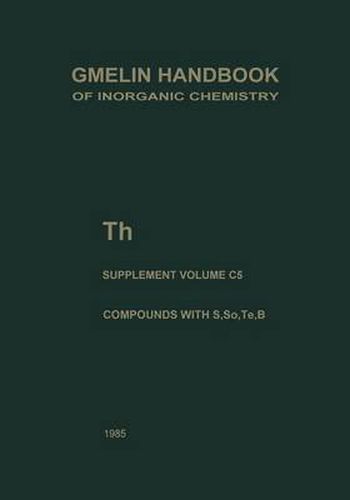Readings Newsletter
Become a Readings Member to make your shopping experience even easier.
Sign in or sign up for free!
You’re not far away from qualifying for FREE standard shipping within Australia
You’ve qualified for FREE standard shipping within Australia
The cart is loading…






This title is printed to order. This book may have been self-published. If so, we cannot guarantee the quality of the content. In the main most books will have gone through the editing process however some may not. We therefore suggest that you be aware of this before ordering this book. If in doubt check either the author or publisher’s details as we are unable to accept any returns unless they are faulty. Please contact us if you have any questions.
The present volume, Thorium C5, deals with the compounds of thorium and sulfur, selenium, tellurium, and boron, as well as with oxoacid compounds of the three chalcogen elements. Thorium borates have already been treated in Thorium C2. In contrast to the corresponding compounds of uranium the thorium sulfides, etc. , do not show any nuclear or other technological application; they are only of academic interest, despite some very interest ing electronic properties, especially of the 1 : 1 compounds. The thorium-sulfur and the thorium boron systems in particular were studied in detail, so that we have a clear picture of them, whereas there are still a lot of open questions in the systems Th-Se and Th-Te - not very different from other metal chalcogenide systems. Thorium sulfates are of some technological importance because they are formed in solution during recovery of thorium from monazite by sulfuric acid leaching. The very detailed and critical treatment of the chemical and physical properties of the compounds discussed also enables us to find gaps still remaining in our knowledge and thus to initiate new research in this field. I want to thank the two authors, Dr. Horst Wedemeyer (Karlsruhe) and Dr. David Brown (Harwell), for their excellent contributions, the Literaturabteilung of the Karlsruhe Nuclear Research Center for its help in providing reports and other documents difficult to procure, as well as the staff of the Gmelin-Institute, especially to Dr. K. -C.
$9.00 standard shipping within Australia
FREE standard shipping within Australia for orders over $100.00
Express & International shipping calculated at checkout
This title is printed to order. This book may have been self-published. If so, we cannot guarantee the quality of the content. In the main most books will have gone through the editing process however some may not. We therefore suggest that you be aware of this before ordering this book. If in doubt check either the author or publisher’s details as we are unable to accept any returns unless they are faulty. Please contact us if you have any questions.
The present volume, Thorium C5, deals with the compounds of thorium and sulfur, selenium, tellurium, and boron, as well as with oxoacid compounds of the three chalcogen elements. Thorium borates have already been treated in Thorium C2. In contrast to the corresponding compounds of uranium the thorium sulfides, etc. , do not show any nuclear or other technological application; they are only of academic interest, despite some very interest ing electronic properties, especially of the 1 : 1 compounds. The thorium-sulfur and the thorium boron systems in particular were studied in detail, so that we have a clear picture of them, whereas there are still a lot of open questions in the systems Th-Se and Th-Te - not very different from other metal chalcogenide systems. Thorium sulfates are of some technological importance because they are formed in solution during recovery of thorium from monazite by sulfuric acid leaching. The very detailed and critical treatment of the chemical and physical properties of the compounds discussed also enables us to find gaps still remaining in our knowledge and thus to initiate new research in this field. I want to thank the two authors, Dr. Horst Wedemeyer (Karlsruhe) and Dr. David Brown (Harwell), for their excellent contributions, the Literaturabteilung of the Karlsruhe Nuclear Research Center for its help in providing reports and other documents difficult to procure, as well as the staff of the Gmelin-Institute, especially to Dr. K. -C.